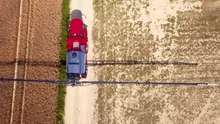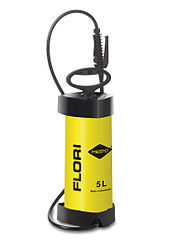Plant protection device
A plant protection device (commonly a sprayer ) is used in agriculture for plant protection and fertilization . It atomizes liquids and distributes them to plants and / or soil . It is used in arable farming , horticulture , fruit and viticulture and silviculture . Different spray nozzles, pressures and speeds are used for different applications.
Plant protection devices are either guided and operated by hand, by tractors , as independent vehicles (self-propelled sprayers) or by agricultural aircraft .
Garden sprayer
Garden sprayers usually have a capacity of a few liters and can therefore be carried in the hand or on the back.
- In the case of simple hand sprayers, an air pump generates overpressure in the storage container before application , so that the liquid moves towards the spray nozzle via a connected hose. If the pressure has dropped more, you have to interrupt the application to re-pump.
- In the case of syringes carried on the back, the spray mixture is usually pressed continuously from below into an air-filled pressure vessel by means of a hand-operated pump, from which it can escape via a hose with a manual valve and nozzle.
Garden syringes are often in garden in plant protection uses. In agriculture, for example, they are used for the selective treatment of small treatment areas or in special crops.
Sprayer

A field sprayer is an agricultural device that pesticides or liquid fertilizer can be distributed uniformly to agricultural land. In the case of field sprayers, the spray mixture is brought under pressure by a liquid pump downstream of the storage container and then distributed by means of spray nozzles.
One distinguishes
- Attachment (attachment to the three-point hydraulic system ),
- Construction (construction on a loading area of an equipment carrier , Unimogs , MB-Tracs or Fastracs ),
- Trailer (sprayer with its own chassis is attached to the tractor) and
- self-propelled sprayers (vehicle with its own engine).
Field sprayers are usually driven by the power take-off shaft or hydraulic motors.
The maximum working width of field sprayers was up to 54 m in 2010.
Technical structure and additional functions

- A field sprayer consists of the basic components tank with agitator, pump, filter, fittings and sprayer boom.
- An on-board computer is often installed in modern devices to control the spray pressure as a function of the driving speed.
- The sprayer boom is divided into sections so that you do not always have to work with the full working width.
- A induction hopper can be mounted on the side at a convenient height to fill in the pesticides. This is a container with a capacity of around 40 liters, from which the pesticides are sucked in. For agents in the form of powder or granules, a line is also installed to mix and rinse these substances with broth from the container. There is an upward cleaning nozzle for cleaning canisters.
- In order to prevent deposits in the tank or an uneven distribution of the substances to be applied within the spray liquid, an agitator is usually available for continuous mixing. For older and v. a. For larger devices, a mechanically driven shaft with agitator blades was common, while hydraulic agitators are now mostly used. If there is no separate pump for this, the pump in these syringes delivers significantly more liquid than can be dispensed via the nozzles at the same time. This excess amount is returned to the tank via the valve. Pipes with many small bores or special injector nozzles are then used as agitator nozzles.
- With newer devices, cleaning nozzles in the tank are used for better cleaning after use. Herbicide residues in the sprayer usually have a serious effect on the growth of other subsequently treated crops.
- Blast walls can be built into the tank to prevent the syringe from rocking when it is partially filled. These thus increase traffic safety, but on the other hand make cleaning the inside of the container more difficult.
- A clear water tank for storing rinse water is now also required for new devices, as is a cleaning lance with which the rods are cleaned from the outside.
- A field sprayer has several filter units to reduce clogging of the nozzles: First, sieves in the filling opening and filters on the suction side, which filter the water / fertilizer solution. The spray liquid, which has been provided with pesticides, then passes through filters on the pressure side and again in front of the nozzle mouthpieces.
- The boom of area sprayers usually has spray nozzles made of plastic, brass, stainless steel or plastic-ceramic combinations at a distance of 50 cm across the direction of travel. In front of the nozzle mouthpieces, membrane valves are usually arranged, which only let liquid through when a defined minimum pressure is reached in order to prevent the nozzles from dripping and the line from running empty after switching off. The emerging spray jet has an angle of 110 or 120 degrees. For the strip-by-strip treatment, for example in sugar beet cultivation, so-called band sprayers use nozzles with 80 or 90 degrees, which only spray a narrow band around the sowing row, while herbicides are not applied in the strips in between when weed control there should be done mechanically.
- The latest models offer the option of flushing the boom line without the nozzles spraying liquid. With this technology, it is also possible that the full concentration of pesticides is applied to each nozzle right at the start of work.
- A slope control controls the boom via ultrasonic sensors or manual operation at an even distance from the treated area.
- Multiple nozzle holders are optionally available, with which another nozzle can be selected quickly by turning it slightly.
- Occasionally, two boom lines with different nozzles are installed in order to be able to vary the dosage depending on the driving speed and application without changing the nozzle.
Area-specific treatments
- Thanks to GPS technology, it is now possible to automatically switch sections or even each spray nozzle individually. This is particularly advantageous for wedge-shaped treatment surfaces and wide rods.
- With GPS technology, too, it has long been possible to create maps on the home computer, which provide different application rates for the respective partial areas. The on-board computer receives this data via USB or Bluetooth connection. Then, depending on the notified location, he can control the application rate as prescribed.
- Engineers are working on 2-tank pre-mix systems. The sprayers have 2 or more tanks: a large one filled with water and one or more small tanks with a high concentration of the pesticides in the water. The concentration of the pesticides in the final spray liquor is continuously computer-assisted to adapt to the different infestation pressure on the area.
Special application techniques
A distinction must be made here between air injector nozzles, active air admixture, air hose systems, sleep-door systems and multi-hole nozzles .
The aim of many recent developments is to reduce losses due to wind, also known as drift . In connection with the choice of the application parameters nozzle size, pressure, driving speed and drift reduction classes, it is possible to achieve the so-called drift reduction classes 50%, 75% or 90% drift reduction. Compliance with these classes is required as part of the approval of the plant protection products by the Federal Office for Consumer Protection and Food Safety in order to be able to use certain preparations at all or to be able to reduce the distances to bodies of water or non-target areas with other preparations.
- Air injector nozzles have air inlet openings on the side and thus generate a coarser droplet spectrum. They are less suitable for contact-effective pesticides, but they have the advantage of less drift.
- Double flat jet nozzles with or without air injection should penetrate the crop at an angle so that not only the top parts of the plants are wetted. With some nozzle models, the arrangement of the slots is asymmetrical in order to compensate for the influence of the forward speed.
- With active air admixture, compressed air is admixed with the spray liquid in the compressor directly at the nozzle.
- The older air hose systems create an enormous air flow around the spray cone to shield them from the wind and at the same time to open up the vegetation. In this way, even deeper leaves and the back of the leaves can be treated. In addition to the energy expenditure, the background noise and the additional weight are disadvantageous. In addition, there may be disadvantages in terms of effectiveness due to the raising of dust.
- The tow system effects a targeted treatment of parts of the plant by pressing down and opening the crop. Nozzles are mounted directly behind the cloth at a distance of only 50 cm, which spray the crop at an angle. In the latest developments, the cloth has been replaced by flexible metal plates.
- Multi-hole nozzles, often called pee nozzles in specialist circles, have several openings from which bundled jets emerge. They are particularly suitable for the application of liquid fertilizers, where a fine distribution would lead to corrosion damage.
The latest developments deal with combinations of several nozzles that are in operation at the same time in order to react to fluctuating application requirements and to obtain a practical spray pattern. In addition, nozzles are being tested that should be suitable for driving speeds of 15 km / h or more.
Syringes for special crops
Sprayers for room crops
Sprayers for spatial crops are found in growing areas where vines and fruit are grown. They are pulled by a tractor and are designed as either a mounted or a trailed sprayer. With these devices, the spray mist is distributed by means of a fan so that the parts of the plant to be protected are sufficiently wetted. The air flow ensures that parts of the plant that are partially covered by leaves, as well as the back of the leaves, can be reached. There are nozzles that produce both the smaller and the larger drops. Large drops have the advantage that there is less wind drift. Both flat jet nozzles with or without an injector and hollow cone nozzles can be used here.
Under floor spraying
In viticulture and fruit growing, herbicide sprayers are often used under the rows, while the drivable area is mechanically processed or the vegetation there is regularly mulched. In the case of the under-floor sprayers, usually only a single nozzle is arranged on both sides of the tractor or an attachment. Due to the small amount of spray liquid, there are devices that use a small electric motor to drive the pump, which is supplied from the tractor's electrical system.
For smaller areas of use, or, for example, to be able to remove vines with green shoots on the trunk from the application, the knapsack sprayers listed under garden sprayers are also common.
Web links
Individual evidence
- ↑ Page no longer available , search in web archives: Technical documentation on plant protection training in Bavaria (PDF; 751 kB).
- ↑ Page no longer available , search in web archives: Page of the widest CHD syringe , visited on February 24, 2010.
- ↑ Page no longer available , search in web archives: crop protection sprayer with tow







